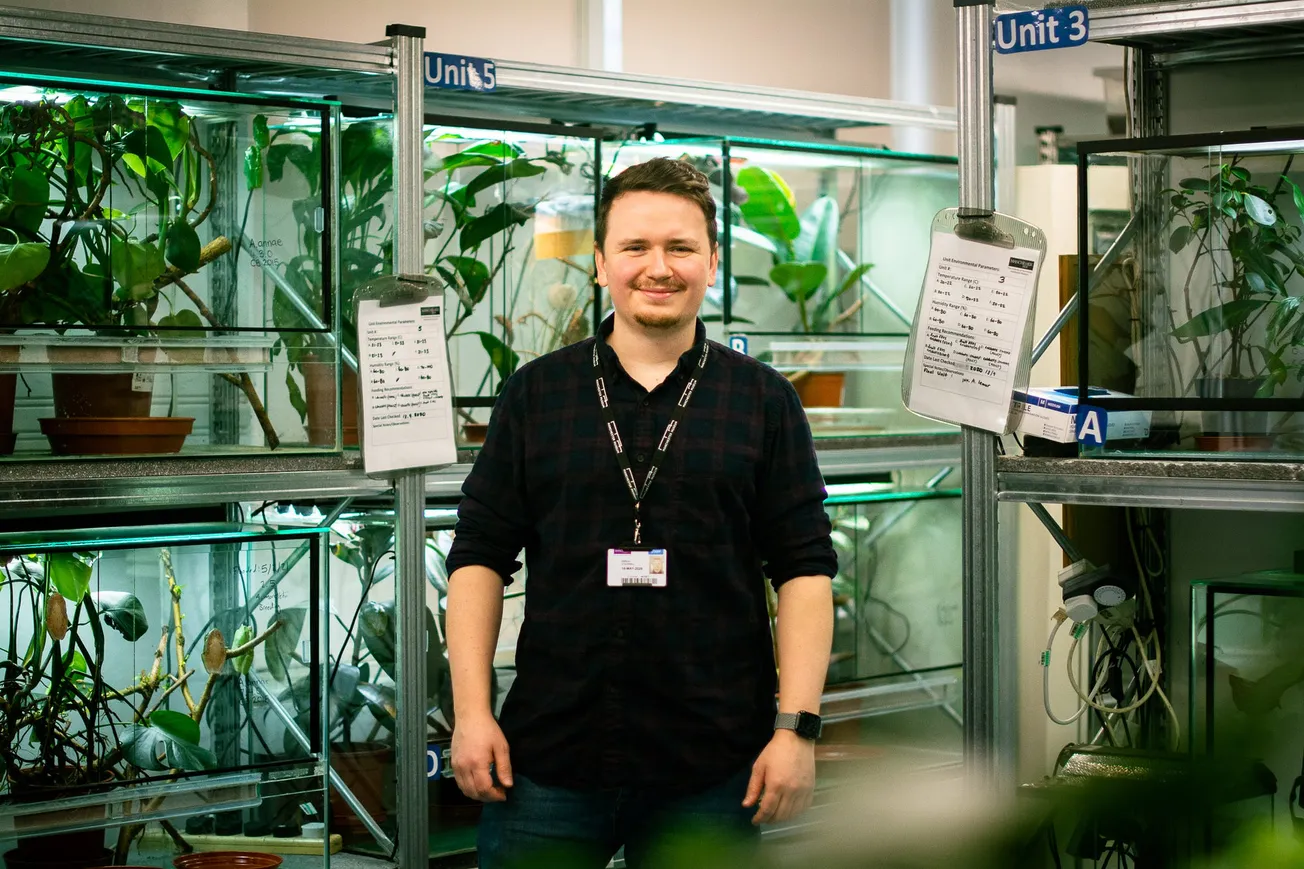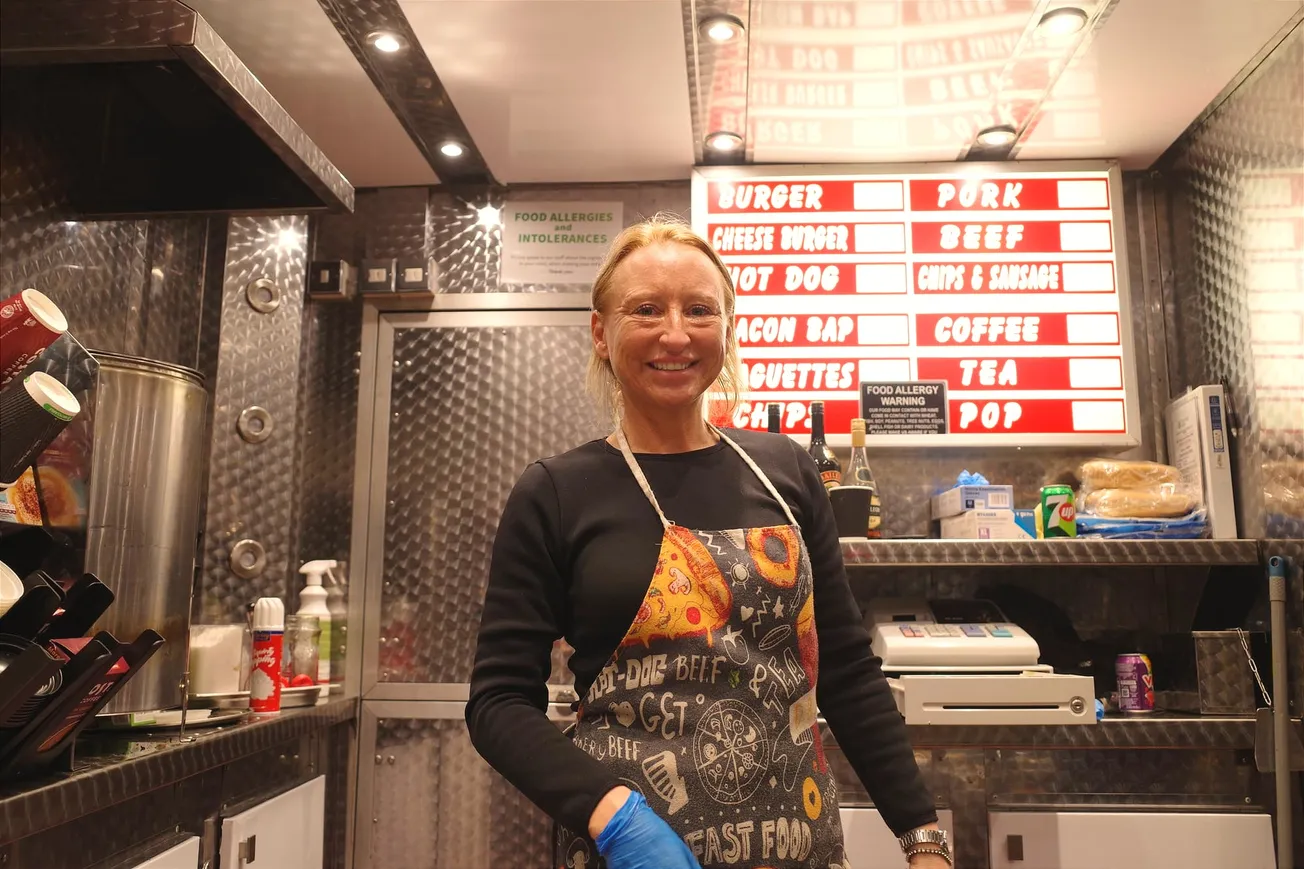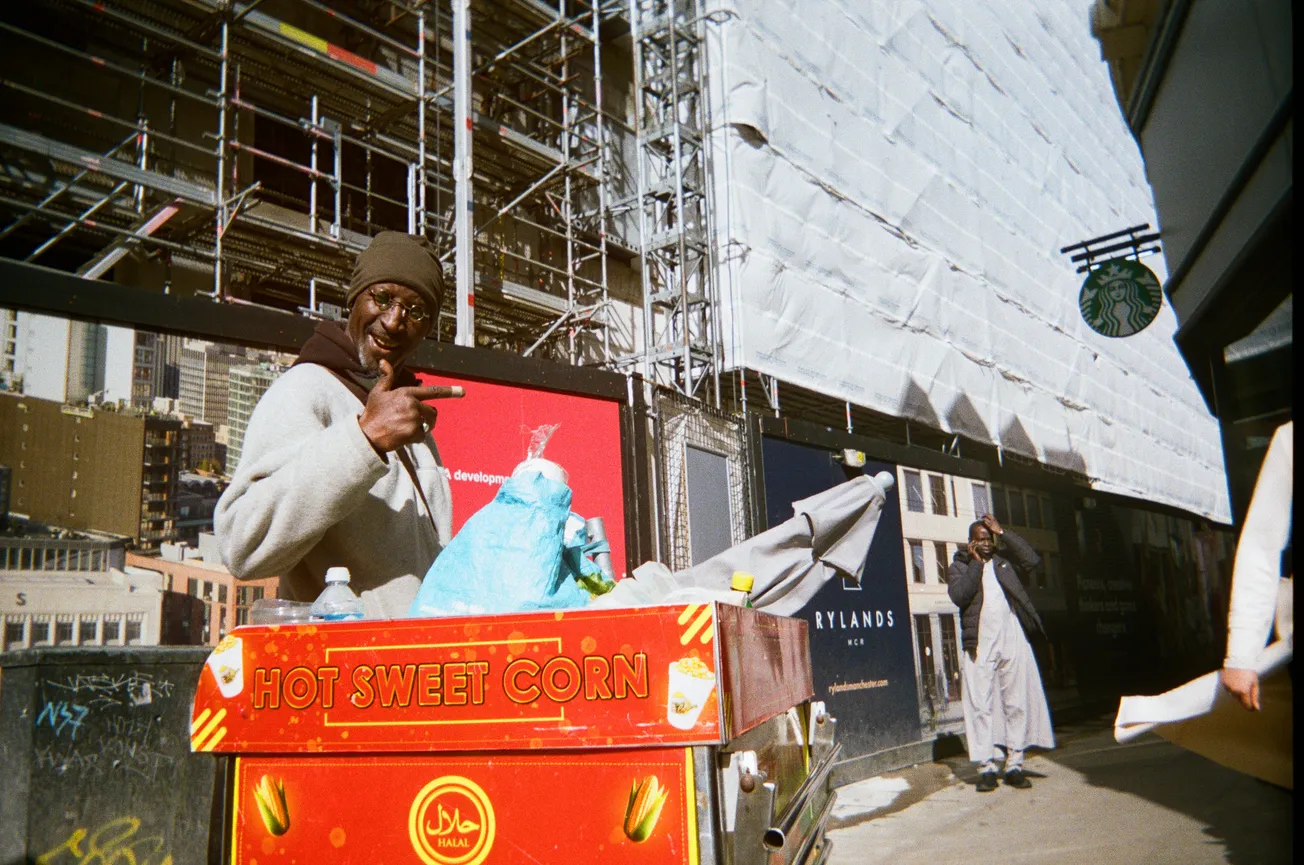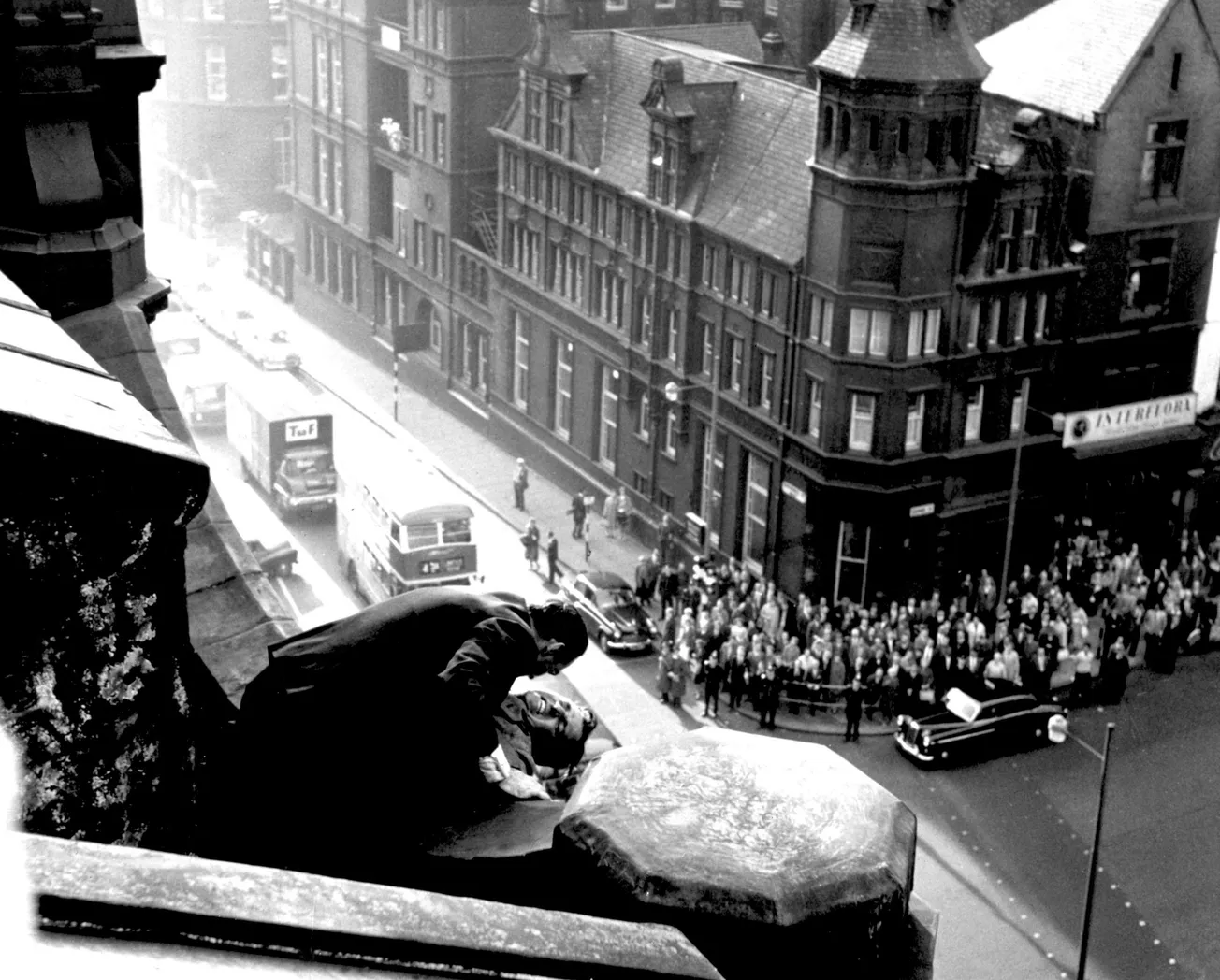By Dani Cole
One morning, Matthew O’Donnell, the curatorial assistant at Manchester Museum’s Vivarium, came into work and quickly became alarmed. One of the breeding pairs of harlequin toads in the backroom’s aquarium had separated.
The incredibly rare and endangered toads had spent the past month in amplexus — the frog mating hug — and their uncoupling heralded an important development: the female had found somewhere to spawn.
“I got panicked a bit,” Matthew says. “I couldn’t see any eggs.” He called his colleagues — Andrew Gray, Curator of Herpetology and fellow curatorial assistant, Kasia Majewski. Together they spent a couple of hours wondering what they should do. It was decided that they should wait a week before looking for any eggs.

The frogs were returned to their terrestrial tanks and given a good feeding — harlequin toads are committed breeders, and the male, much smaller than the female, will not eat for the entire time he’s in amplexus. Like coaches and athletes before an event, the team at the museum make sure the frogs are in ‘tip-top condition’ before mating and keep a close eye on their body mass and health. Males can lose up to 30% of their body weight when they’re in amplexus.
A week passed. Matthew, Kasia and Andrew got impatient. They decided to look for the eggs — or, if they were lucky, tadpoles. They inspected the rocks in the aquarium one by one. With each bare rock, their hopes of a successful breeding dwindled.
“We were pretty downhearted but then we found them,” Matthew recalls. Under the very last rock — a cluster of tadpoles. There was running, shouting, crying all around. “It was amazing.”

From Santa Fe National Park to Oxford Road
These frogs, small enough to fit into the palm of a toddler’s hand, are precious. Their presence in the museum — and the arrival of the tadpoles — was the culmination of three years of rigorous, extensive preparation, and could help to secure the future of a species that many experts thought had disappeared from their natural habitats in Panama and Costa Rica.
Atelopus varius is on The International Union for Conservation of Nature’s red list of threatened species. It is thought that 83% of harlequin toad species are critically endangered or extinct in the wild. The frogs that were brought to the museum came from a population that was first identified inside Santa Fe National Park 13 years ago.
Manchester Museum, which is housed in a stunning neo-Gothic building on Oxford Road and whose 4.5 million items make it the UK's largest university museum, has been supporting a Panamanian-led conservation effort to save the harlequin toads.
“We’re incredibly proud that we were invited to be involved in the project and lend some expertise,” Matthew says. The successful breeding of the frogs at the museum is a major boost for the species, but much of the work was done in Panama. The Panama Wildlife Conservation developed all the baseline data, helped the museum secure travel permits, and did extensive work in the field.
The museum’s team specialise in non-invasive research. He tells me that in the past, scientists (not the ones at the museum) would cut off frogs’ toes when attempting to ‘describe’ the species. These days technological developments such as biometric scanning — which identifies the unique patterns on the frogs’ backs — help with the monitoring of the species.

The frogs arrived in Manchester in January 2019. Their journey was a momentous one: their native habitat, Santa Fe National Park in Panama is 5,500 miles away. They had been flown over the Atlantic Ocean carefully packed in custom-made containers and held in place with sponge and leaf-litter, and wrapped in insulation.
That journey followed years of focused work in Panama by the museum’s team, their group of dedicated volunteers, and colleagues Dr Luis Urena and Dr Flores from the Panama Wildlife Conservation charity (PWCC).
PWCC had been monitoring the population of harlequin toads in the park for several years and were able to find suitable animals for transfer to Manchester. They were highly conscious of making sure the removal of the younger frogs had minimal impact on the existing population. Finding the frogs involved trekking through lush, verdant jungle, navigating waterfall faces and clambering over slick rocks in rubber boots.
On the flights to England, they had their own chaperone, Andrew, who went to Panama to supervise their transfer. As the harlequin toads had come from mountain streams, they could tolerate temperatures of 16 – 24 degrees. This meant transporting them was easier, but it was still vital the animals were not stressed.

As the frogs were young when they arrived, the team were unsure of the sexes – but in the end, it turned out to be a perfect ratio: three males and three females.
Finally seeing the toads, banded in vivid yellow and black, was a special moment for Matthew. “We were delighted when we got them here,” he says. “It was one of the highlights of my career because I had never seen them before. They’re so rare.” There are captive populations of a close relative of the harlequin toad, the Panama golden toad Atelopus zeteki in North American collections, but the harlequin toads are both a first for Manchester Museum and for Europe.
Having safely received the amphibians, the next challenge was getting them to reproduce successfully. The team had bred other species of neotropical toad before and this experience helped them when it came to fine-tuning the formula for the harlequin toads.
“We were quite confident — but even so, it was still nerve-wracking at first,” he says. For Matthew and his colleague Bethany Dean, there were so many factors to consider: Had they got the nutritional balance right? Were they feeding the toads enough? The first successful reproduction actually took place about a year ago, but the museum held the announcement off — they wanted to make sure everything was progressing as it should.
Because of the pandemic, the volunteers who usually help haven’t been able to see the fruits of their labour. But they were sent regular updates. “They’re an amazing bunch,” Matthew says. “We can’t wait to welcome them back.”

‘People relate more with frogs’
Matthew shows me where the harlequin toads will be displayed when the museum reopens. With no visitors, it is quiet except for the noise of running water and occasional echoes from other parts of the museum.
The display is unfinished, but the first admirers inside the museum are still not expected to flock back for a couple of months. An artificial rock formation —made from a specialist blend of resins, concrete and fibre, sealed with non-toxic paint — is lit by two types of bulbs: daylight-rated bulbs that mimic natural sunlight, and UV lights. “Like tanning bulbs,” he explains. The lights will cycle between 12 hours of day and 12 hours of night because Panama is close to the equator.
Surprisingly, Oxford Road is a good environment for the frogs. “It’s hard to replicate Panama in Manchester. But we’ve managed to do it,” he laughs. Manchester is generally humid and the water is “quite nice” for the harlequin toads. “We just need a bit of peat extract to help with the larval forms of amphibian development,” he says.

I’m taken to the backroom where the frogs and other herpetological species are housed. It is scrupulously clean, small, bright, and warm. I am gently sweating after a few minutes — but it is a perfect temperature if you are a frog. On the back of the door there is a whiteboard where Matthew has drawn out a waterfall display. He jokes he missed out on another career in art.
Each tank is filled with plants. Care has been taking to ensure the plants replicate each animal’s natural habitat. For the harlequin toads, their tanks have bromeliads — a family of plants that would be found in Panama.

The toads are much smaller than I expected — they are colourful and smooth — not the grey-green, unpleasant creatures usually associated with toads. “Six days of the week it soils/With its sickening poison,” Philip Larkin wrote in his poem Toads.
The entire time Matthew talks about the harlequin toads, he uses the ‘frog’ and ‘toad interchangeably. This is because toads are a family of frogs: all toads are frogs, but not all frogs are toads. Interestingly, when it comes to fundraising and getting public support, the team uses the word ‘frog’. “People relate more with frogs than toads,” he says.
Matthew has to wear gloves when he handles the frogs — they are very sensitive. The gloves prevent the frogs from absorbing any salts, perfumes and hand gels that might be on his skin. He shows me one of the baby frogs, an adult male and I also see two toads in amplexus — the female keeps hopping around, the male resolutely clinging on for dear life. “These are pretty plump frogs,” Matthew says.
A lifelong passion
Matthew, who grew up in Crumpsall and Prestwich, was “obsessed” with amphibians as a child. His passion for the subject stemmed from being into dinosaurs at a young age. “Finding out these animals had been around before the dinosaurs, and they were still here, really captured my imagination,” he says.
He tells me about the diversity of this group of organisms: from the fully-aquatic salamanders to arboreal species that spend their entire lives in trees and canopies.
He followed his passion for the sciences throughout school and college, before doing a BA in Zoology and then a MSc in Wildlife Conservation at the University of Salford. He’s currently undertaking a PhD at the University of Salford alongside his work at the museum.
“I always pictured myself out in the field and working directly in conservation,” he says, but he soon realised the value of working in live herpetology collections. He’s been at Manchester Museum for seven years, and his work has taken him out to Costa Rica.

Amphibians are quite prehistoric in how they behave – frogs in particular: the wobbling, almost gelatinous eggs; their larvae which look like dark, ancient fish cushioned in translucent sacs; the mysterious, sprouting hind legs. Matthew remembers that there used to be frogs in his garden, and his parents let him build ponds and mess around. He was jealous of the friends who had newts in their gardens
As well as caring for the harlequin toads at the museum, Matthew also has frogs at home: golden mantella and Bumblebee poison dart frogs — Dendrobates leucomelas — that he’s bred himself. “Some of my little babies have been on display here at the museum,” he says with a smile.
Now his work at the museum means he is involved in high-stakes conservation efforts. The harlequin toad faces dire threats on several fronts. The chytrid fungus — which affects the frogs’ ability to absorb water — has been wiping out populations across Central America, which are already low because of the trade-in exotic pets.
Despite being difficult to keep, the harlequin’s striking colours made them a popular commodity on the international pet market, and before the 1990s, traders scooped them up in large numbers.
Then there is the issue of illegal deforestation. According to the Rainforest Foundation, “between 2001 and 2019, Panama lost 414,000 hectares (or 7.3%) of its tree cover, including 73,000 hectares of primary rainforest.” The devastation is worst in the Darien region, which is where these particular toads are from.
As of 2018, it is believed that 37 harlequin toad species had disappeared from their habitats. There is a real danger that the animals could disappear in the near future, and the extinction of the frogs would have major consequences for the ecosystem.
The harlequin toads at Oxford Road are now ambassadors for their counterparts back in Panama. Matthew says that they hope the frogs will help raise public awareness about the species and that having a captive population of harlequin toads in Manchester means that the species is one step closer to being saved from vanishing forever.
“These systems have been in place for millions of years,” Matthew says. “If you remove the amphibians from that environment, it could be catastrophic.”

Comments
How to comment:
If you are already a member,
click here to sign in
and leave a comment.
If you aren't a member,
sign up here
to be able to leave a comment.
To add your photo, click here to create a profile on Gravatar.






